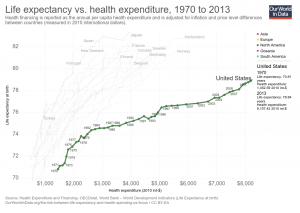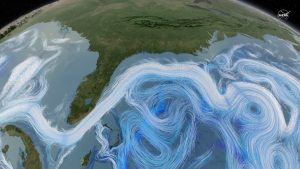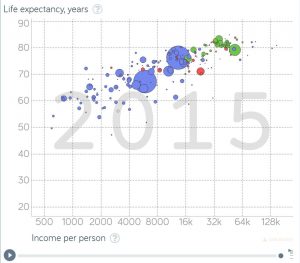 Where do carbon emissions go seems like an obvious question. Into the air of course. If so, then one would expect a near perfect linear relationship between emissions and atmospheric CO2. The graph here has yearly carbon emissions in million tonnes per year (as reported by the Global Carbon Project) vs atmospheric CO2 in ppm from Mauna Loa (see data in the calculus project page). The graph may not be as linear as expected and, while maybe some of it is explained by issues of mixing in the atmosphere or the need for a lag, part of the answer is based on where the carbon goes after it has been emitted. A recent NYT article, Carbon in the Atmosphere is Rising – Even as Emissions Stabilize, sheds some light on the issue:
Where do carbon emissions go seems like an obvious question. Into the air of course. If so, then one would expect a near perfect linear relationship between emissions and atmospheric CO2. The graph here has yearly carbon emissions in million tonnes per year (as reported by the Global Carbon Project) vs atmospheric CO2 in ppm from Mauna Loa (see data in the calculus project page). The graph may not be as linear as expected and, while maybe some of it is explained by issues of mixing in the atmosphere or the need for a lag, part of the answer is based on where the carbon goes after it has been emitted. A recent NYT article, Carbon in the Atmosphere is Rising – Even as Emissions Stabilize, sheds some light on the issue:
Scientists have spent decades measuring what was happening to all of the carbon dioxide that was produced when people burned coal, oil and natural gas. They established that less than half of the gas was remaining in the atmosphere and warming the planet. The rest was being absorbed by the ocean and the land surface, in roughly equal amounts.
In essence, these natural sponges were doing humanity a huge service by disposing of much of its gaseous waste. But as emissions have risen higher and higher, it has been unclear how much longer the natural sponges will be able to keep up.
In fact, much of the carbon is absorbed in the ocean and land surface, and that will add variability to the relationship. The Global Carbon Project has this data available and it can be used by teachers. Go to their page and click on the global budget link for the data, which includes ocean and land sinks of carbon. If you want the data that created the graph on this page go here.
 Climate Central reports, At Midway Point 2017 Is 2nd-Hottest Year on Record, and notes in the first line that this is a surprise given it is not an El Nino year (graph here is by and links to NASA).
Climate Central reports, At Midway Point 2017 Is 2nd-Hottest Year on Record, and notes in the first line that this is a surprise given it is not an El Nino year (graph here is by and links to NASA).
 Where do carbon emissions go seems like an obvious question. Into the air of course. If so, then one would expect a near perfect linear relationship between emissions and atmospheric CO2. The graph here has yearly carbon emissions in million tonnes per year (as reported by the
Where do carbon emissions go seems like an obvious question. Into the air of course. If so, then one would expect a near perfect linear relationship between emissions and atmospheric CO2. The graph here has yearly carbon emissions in million tonnes per year (as reported by the 

 How much has pretax income grown by earner percentiles? The graph here, from Chicago Booth Review’s article
How much has pretax income grown by earner percentiles? The graph here, from Chicago Booth Review’s article 


